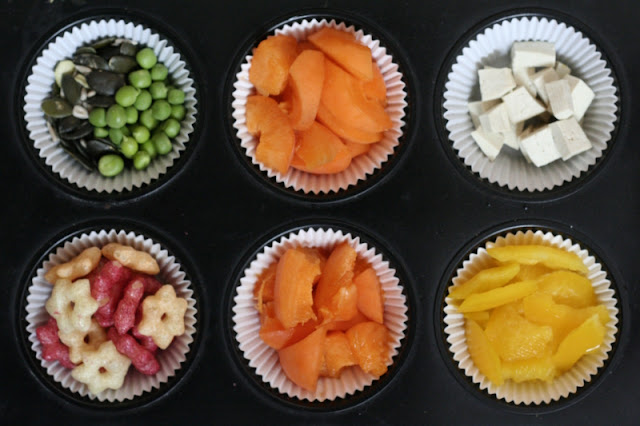No i stało się. Od poszukiwań ciekawych zajęć dla Aniki się zaczęło, a skończyło się na tym, że absolutnie wchłonęło mnie studiowanie trzech "metod" wychowania (i edukacji) dzieci: Montessori, Waldorf i Reggio Emilia.
Na razie się wczytuję i zgłębiam wszystkie trzy, ale w kwestii z tytułu posta zaciekawiło mnie podejście Montessori: dziecko / dzieci mają przez cały czas nieograniczony dostęp do (swojego) jedzenia i mogą sobie przygotowywać przekąski, kiedy mają na to ochotę. Hmm, jak pomyślałam o mojej Mini, która zajada się rodzynkami i żurawiną, i ciągle jej mało (ma się wrażenie), to trochę się przeraziłam. Ale! Oczywiście wspomniane dzieci nie mają dostępu do nieograniczonych ilości wszystkiego, co mogłyby zjeść. To już coś. Z pewną nieufnością postanowiłam dopasować tę ideę do naszych warunków (nie mam, póki co, gdzie urządzić Anice jej osobnej "kuchni") i tak powstała taca z przekąskami.
Pomysł jest banalnie prosty: po śniadaniu przygotowuję 6 porcji przekąsek, które mają Anice wystarczyć na cały dzień. Około godziny 10 Mała dostaje tacę i może sobie z niej jeść, kiedy ją na to najdzie ochota. Jedna zasada: nie ma dokładek. W ten sposób kontroluję ilość zjedzonych słodkości (wprawdzie u nas to tylko rodzynki, żurawina i spółka, ale cukier to cukier i nawet w najzdrowszej formie nie należy jeść go bez ograniczeń) i jednocześnie zachęcam ją do próbowania innych rzeczy. Trochę to podstęp, ale jak ma ochotę coś przekąsić, a żurawinę już zjadła, to zabiera się za inne wyłożone smakołyki.
Po pierwszym dniu byłam zaskoczona. Zniknęło wprawdzie prawie wszystko, ale Anika nie wołała o więcej. Po pierwszym tygodniu mogę donieść, że poprosiła tylko o jedną dokładkę: suszonych bananów - a to dlatego, że jest to dobro bardzo reglamentowane.
Poniżej pochwalę się Wam naszymi tacami z jednego tygodnia (zamiast niedzieli jest poniedziałek, bo całą niedzielę - od 6:30 do 18 - spędziliśmy poza domem). Poza pokazanymi przekąskami, moje inne pomysły to: wszelkie owoce i warzywa, suszone pomidory, orzechy, fasola, kiełki (słonecznika), oliwki i ser.
Jeśli ktoś ma inne pomysły, co mogłabym dodać, to chętnie poczytam. Piszcie!
Jeśli ktoś ma inne pomysły, co mogłabym dodać, to chętnie poczytam. Piszcie!
Do następnego,
pa,
a.
surowy groszek - morela - pestki dyni - żurawina - pszenica z melasą i migdałami
Monday
peas - apricot - pumpkin seeds - cranberries - wheat with molasses and almonds
ugotowana ciecierzyca - pestki dyni - jabłko - ogórek - groszek
Tuesday
boiled chickpeas - pumpkin seeds - apple - cucumber - peas
ogórek - groszek - ugotowana ciecierzyca - morela - suszone banany -
pestki dyni i nerkowce
pestki dyni i nerkowce
Wednesday
cucumber - peas - boiled chickpeas - apricot - dried bananas - pumpkin seeds and cashews
pestki dyni - chrupki kukurydziane - ogórek - pomidor - groszek - morela
Thursday
pumpkin seeds - puffcorn - cucumber - tomato - peas - apricot
papryka - groszek - ogórek i pomidor - chrupki kukurydziane - pestki dyni i słonecznik
Friday
bell pepper - peas - cucumber and tomato - puffcorn - pumkin and sunflower seeds
tofu - morela (przywieziona przez moich rodziców z Chorwacji)
- groszek, słonecznik i pestki dyni - papryka - morela - chrupki kukurydziane
Saturday
apricot (my parents brought from Croatia) - peas, sunflower and pumpkin seeds
- bell pepper - puffcorn
- bell pepper - puffcorn
tofu - morela - suszone banany - chrupki kukurydziane - ogórek - papryka
Monday
tofu - apricot - dried bananas - puffcorn - cucumber - bell pepper
And so I have it. I started searching for some crafts and activities for Anika and I ended up studying three methods of upbringing (and educating) children: Montessori, Waldorf and Reggio Emilia.
After the first day I was quite surprised. Almost everything was eaten up, but Anika didn't ask for any seconds. After the first week, I am glad to report, that she asked for seconds just once: dried bananas - and that's because it's a goods that we strictly reglament around those parts.
For now I'm getting to know all three of them, but the topic mentioned in the title of the post is handled in a very interesting way in Montessori: child / children have unlimited access to their food and they can prepare snacks whenever they feel like it. Hmm, when I thought about my raisins and cranberries munching daughter, I got a bit anxious. But! Of course the kids do not get to eat unlimited amounts of all they could eat. That's something. With certain doubts I decided to match the idea to our conditions (for now I don't really have a place for Anika's "kitchen") and so I came up with "the snack tray".
The idea is banally simple: after breakfast I prepare 6 portions of snacks, that need to last the whole day. At around 10 am Anika gets the tray and can eat whenever she wants. One rule: no seconds. In this way I have her sweets intake under control (she eats only raisins, cranberries & co., but sugar even in its healthiest form should not be eaten without limits) and I get to encourage her to eat other things. It's a bit sneaky, but when she wants to have something and the cranberries are all gone, she will eat something else.
After the first day I was quite surprised. Almost everything was eaten up, but Anika didn't ask for any seconds. After the first week, I am glad to report, that she asked for seconds just once: dried bananas - and that's because it's a goods that we strictly reglament around those parts.
Above you can see our trays from one week (intead of Sunday I show you Monday, 'cause the whole Sunday - 6:30 am to 6 pm - we spent away of home). My other ideas for snacks include: all kinds of fruit and vegetables, dried tomatoes, nuts, beans, sprouts (sunflower), olives and cheese.
If you have any ideas, what I could use, let me know, I'll be happy to read your suggestions.
Tata,
a.










Brak komentarzy:
Prześlij komentarz